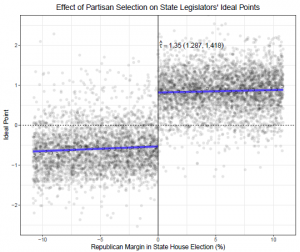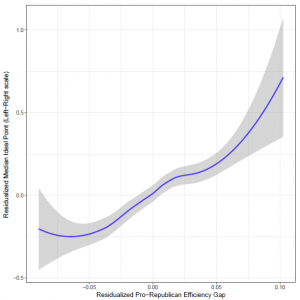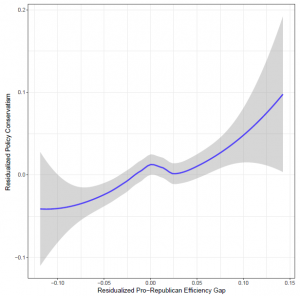The final article I’d like to discuss is Partisan Gerrymandering and the Political Process, by Devin Caughey, Chris Tausanovitch, and Christopher Warshaw, forthcoming in the Election Law Journal. The authors first explore how state legislators’ voting records are related to their margins of victory in the previous election. As shown by the below chart, there is almost no connection at all. A Democrat (or a Republican) from a competitive district is nearly as liberal (or conservative) as one from a safe district. Party affiliation has an enormous effect on voting record, but district composition is just about irrelevant.

This finding suggests that partisan gerrymandering should significantly distort the political process. Gerrymandering enables a party to elect more legislators without winning additional votes. Since these extra legislators are likely to be quite liberal or conservative, they should pull the legislature’s ideological midpoint in the gerrymandering party’s preferred direction. And since legislatures pass laws, the extra legislators should exert a similar influence on enacted policy.
The authors test, and confirm, both of these hypotheses. The below charts plot (1) the state legislature’s median ideal point, and (2) the conservatism of enacted state policy, against the efficiency gap of a district plan. Several variables are controlled for, including, critically, voters’ ideological preferences. In the first chart, a more pro-Democratic (or pro-Republican) efficiency gap leads to a more liberal (or conservative) legislative midpoint. In the second chart, a more pro-Democratic (or pro-Republican) efficiency gap yields more liberal (or conservative) policy outcomes. The effects are also quite large. A plan as pro-Republican as Wisconsin’s Act 43, for example, causes the legislature’s median ideal point to shift to the right by about 0.6 standard deviations.


These results show that the damage of gerrymandering is not limited to seats out of whack with votes. Rather, the harm extends to the entire democratic process. Through the clever design of district lines, a party may skew both legislative representation and enacted policy in its preferred direction. A party may thus push both representation and policy out of alignment with what voters actually want.